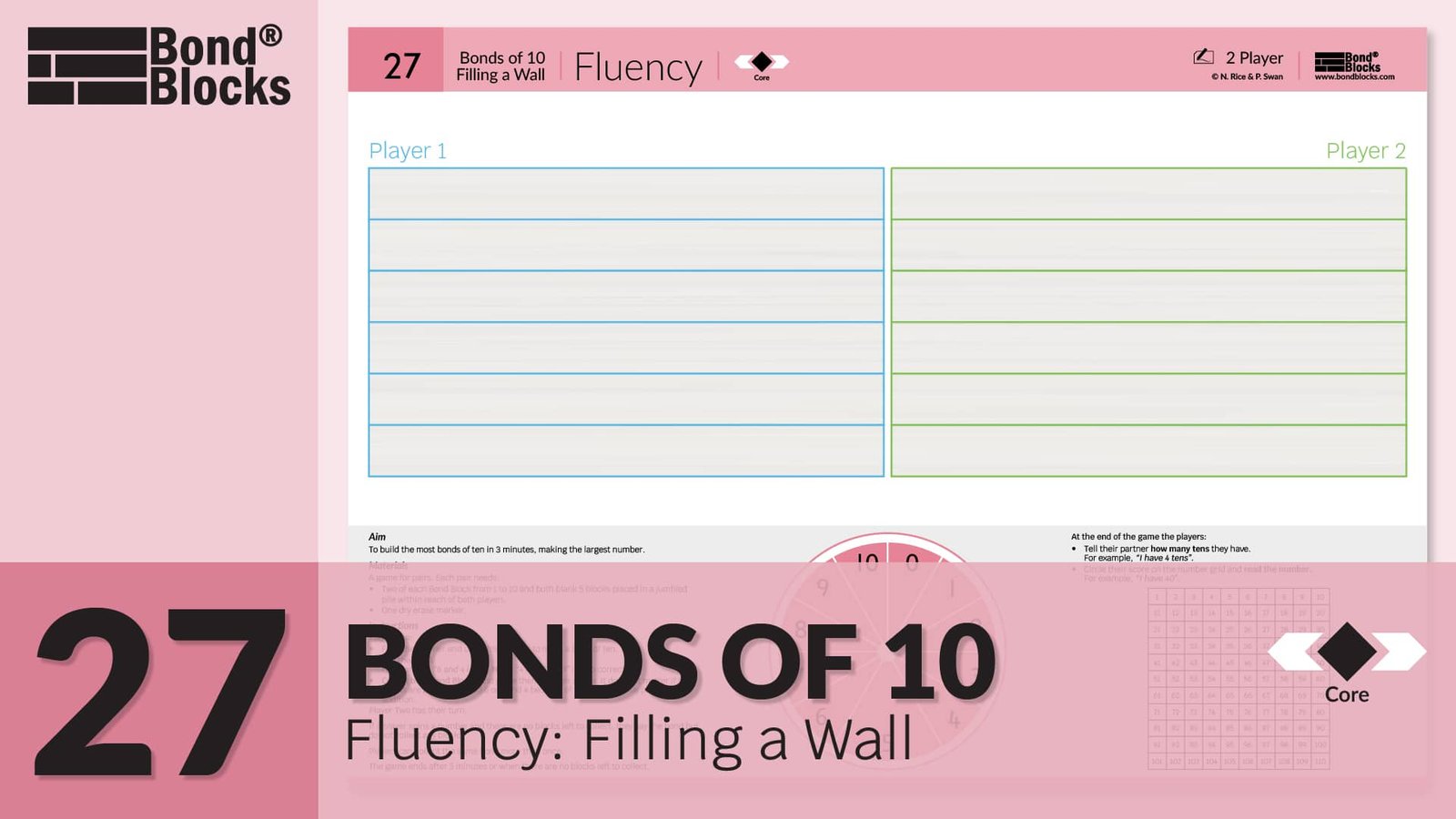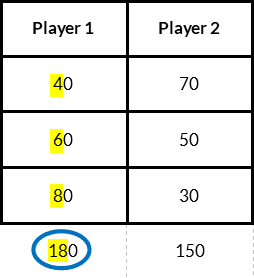27) Fluency
Bonds of 10: Filling a Wall

Mathematics
Develop fluency with two-part bonds of 10.
Develop the concept of counting in ten, starting at zero, as repeatedly adding ten.
Language
- addition as “and”
- equals as “is”
Core Activity Observations
Language “ty” verses “teen”
Listen carefully to students’ pronunciation of “ty” at the end of the game when students tell their partner how many tens they have and circle their score. For example, “I have four tens. I have forty“.
- The “ty” means groups of ten. For example, four tens.
- This is different to “teen” which means ‘add one ten’. For example, “fourteen” is ‘four add one ten’.
Assist students who incorrectly say ‘teen’, instead of ‘ty’ by completing the following activity for individual students. This activity focuses on connecting the number name “forty”, the written number ’40’ and the quantity (Bond Blocks). You will need:
- Bond Blocks made into rows of ten whilst playing Bonds of 10: Fluency Filling a Wall .
- One Number Board: Starting At One. Click to download.
- One pair scissors.
- One pencil.
Instruct the student to:
- Place the Bond Blocks they made into bonds of ten whilst playing Bonds of 10: Fluency Filling a Wall on top of the Number Board Starting at One.
- Count aloud by ten as each row is placed on the Number Board. Ensure the decade number is said correctly.
- Repeat the statement made in Bonds of 10: Fluency Filling a Wall saying the greatest number covered by the blocks. For example, “I have 4 tens. I have forty”.

- Slide the Bond Blocks off the Number Board, keeping the blocks in rows.
- Cut the previously covered rows of the number board into horizontal strips. Place these strips on top of the Bond Blocks the student had made into bonds of ten when playing the Bonds of 10: Fluency Filling A Wall game.
- Count aloud by tens pointing to each multiple of ten of the number board as it is said. Listen for “ty”.

- Count again by tens whilst using a pencil to underline each zero on the number board as the “ty” is said.
- Define “ty” as groups of ten.

Differentiation
A little easier
Counting order
Instead of placing the blocks in a jumbled pile ask the student to first build a wall of 10. Play with the wall assembled before playing with blocks jumbled.

Part-Part-Whole diagrams
Place part-part-whole diagrams next to students, for them to refer to, whilst completing the activity with blocks in a jumbled pile. These diagrams can be useful supports for students with memory or processing difficulties.
There are a variety of visuals to chose from.
Click to download this Bonds of 10 Part-Part-whole Desk Visual. It contains two different visuals:
This visual shows all the two-part bonds of 10.

This visual shows the more difficult to remember two-part bonds of 10.

Click to download this Bonds of 10 and Doubles Desk Visual. This version is smaller and can be taped to the back of a ruler for discrete use by students who are older or self-conscious about using visual supports. The bonds of 10 are dark blue to cater for student who are adverse the the chapter colour of pink. It are also contains the most difficult to remember double bonds.

Click this link to read Teacher Notes for more ideas about “Using Part-Part-Whole Desk Visuals” to support students.
A little harder
Recording scores
Play for three rounds. Each player records their score as a two-digit number. The winning score in each round is circled. The player with the most number of rounds won is the overall winner.

Winning difference as the score
Calculate the difference between each player’s score. The difference becomes the winner’s score.
Line up each player’s blocks to show the difference.
Play for three rounds. The player with the most number of rounds won is the overall winner.

To make this significantly harder students can add their winning differences for each round. The first to 100 wins. Students can use a calculator to add differences and check estimates to see how far away from 100 they are.
A lot harder
Total score
Play for three rounds. Each player calculates the sum (total) of their three scores. The player with the greatest overall score is the winner.

This addition can be modelled with Bond Blocks. The blocks need to be defined as tens, not one. Using Bond Blocks to represent multiples of ten, not one, should only be done once students are fluent with addition and subtraction to 20. Once students do not regularly choose to use the blocks support addition and subtraction to 20, they will be ready to use them as multiples of ten to support addition and subtraction to 100.

Click to download the Number Expander to help students partition three-digit numbers using only tens, instead of the standard partition of hundreds, tens and ones. Flexible partitioning is essential to develop efficient calculating strategies.

Guess my score
Explore how each round adds to 11 tens, or 110.
Ask students to find the total of Player 1 and Player 2’s score after each round. (The answer is 110.) Discuss strategies used. Model adding each player’s score in tens. In the scoring table below each round would be calculated as
- 4 tens + 7 tens = 11 tens, which is 110 ones
- 6 tens + 5 tens = 11 tens, which is 110 ones
- 8 tens + 3 tens = 11 tens, which is 110 ones

This addition can be modelled with Bond Blocks. The blocks need to be defined as tens, not one. Using Bond Blocks to represent multiples of ten, not one, should only be done once students are fluent with addition and subtraction to 20. Once students do not regularly choose to use the blocks support addition and subtraction to 20, they will be ready to use them as multiples of ten to support addition and subtraction to 100.

Ask one student in each pair to cover their score with their hand. State that you know the covered score without seeing it! Tell the student their score and then get them to remove their hand to prove you are right. Ask students how you know their score without seeing it. Model your mental calculation strategies aloud. Students repeat in pairs.

This can be modelled with Bond Blocks. The blocks need to be defined as tens, not one.

Progression
In the next activity students apply five plus bonds to addition. Go to
Activity 28
Bonds of 10: Fluency, Tic-Tac-Toe
